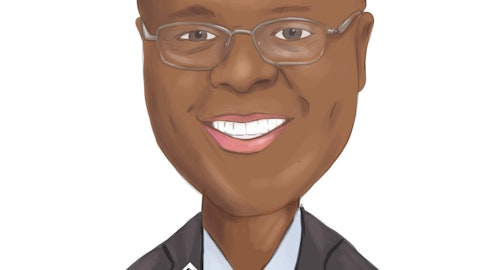United Community Banks, Inc. (NASDAQ:UCBI) Q3 2023 Earnings Call Transcript October 18, 2023
United Community Banks, Inc. misses on earnings expectations. Reported EPS is $0.45 EPS, expectations were $0.46.
Operator: Good morning, and welcome to United Community Bank’s Third Quarter 2023 Earnings Call. Hosting our call today are our Chairman and Chief Executive Officer, Lynn Harton; Chief Financial Officer, Jefferson Harralson, President and Chief Banking Officer, Rich Bradshaw; and Chief Risk Officer, Rob Edwards. United’s presentation today includes references to operating earnings, pretax, pre-credit earnings and other non-GAAP financial information. For these non-GAAP financial measures, United has provided a reconciliation to the corresponding GAAP financial measure in the Financial Highlights section of the earnings release as well as at the end of the investor presentation. Both are included on the website at ucbi.com. Copies of the third quarter’s earnings release and investor presentation were filed this morning on Form 8-K with the SEC and a replay of this call will be available in the Investor Relations section of the Company’s website at ucbi.com.
Please be aware that during this call, forward-looking statements may be made by representatives of United. Any forward-looking statements should be considered in light of risks and uncertainties described on Pages 5 and 6 of the Company’s 2022 Form 10-K as well as other information provided by the Company in its filings with the SEC and included on its website. At this time, I’ll turn the call over to Lynn Harton.
Lynn Harton: Good morning and thank you for joining our call today. As you would expect, we continue to see influences of a higher rate environment this quarter. On the positive side, we had strong deposit growth and excellent liquidity. Customer deposits grew $314 million or 5% annualized this quarter, excluding the first Miami acquisition and the two branches we sold in Tennessee. We do continue to see movement into higher-yielding deposit products with DDA as a percentage of total falling slightly to 30%, down from 31% last quarter. Our liquidity position continues to be very strong. During the quarter, we were able to fund organic loan growth of 5.4% annualized, while paying down over $400 million in broker deposits and still reaching over $750 million in cash equivalents at quarter end, all with essentially no short-term borrowings.
Our loan-to-deposit ratio remained at 80%, providing ample liquidity to meet our customers’ borrowing needs. Our margin continued to be impacted by rate competition and mix change, but the rate of change has slowed. Our net interest margin fell from 337 basis points last quarter to 324 basis points this quarter, a 13 basis point decline. Higher rates are also impacting some of our weaker customers from a credit perspective. As previously disclosed, we took a $19 million charge-off on an 8.7% share of a locally based shared national credit. We also wrote down two memory care centers, which have been on nonaccrual by $3 million, reflecting expected market value for the properties. With the charges, our bank net charge-off ratio, excluding Navitas was 49 basis points, up from 15 basis points last quarter.
Our Navitas subsidiary had increased charge-offs this quarter due to higher losses coming from a relatively small exposure to the long-haul trucking segment. Navitas’ annualized charge-off rate for the quarter was 1.62%. Excluding the long-haul segment, charge-offs in Navitas were approximately 88 basis points for the quarter. Taken together, our consolidated charge-off ratio for the quarter was 59 basis points, up from 20 basis points last quarter. These losses are somewhat unique. The majority of our portfolio continues to perform well and our local economies continue to be very strong. However, we know from history that the combination of rapid interest rate increases and tightening credit conditions can weaken credit performance, at least in some business segments.
We’re cautious in our lending and portfolio management strategies for this reason. In summary, our operating earnings this quarter were $0.45 per share, down $0.10 or 18% compared to last quarter. Our operating return on assets was 79 basis points for the quarter, and our pretax pre-provision ROA was 144 basis points, down 21 basis points from last quarter. On the strategic front, we closed on First National Bank of South Miami, July 1, a deal we announced on February 13 of this year. Conversion is scheduled for this weekend, and we look forward to having their outstanding team fully integrated with the Company. Now I’ll ask Jefferson to provide more detail on our performance for the quarter.
Jefferson Harralson: Thank you, Lynn, and good morning to everyone. I am going to start my comments on Page 7 and go into some more details on deposits. As Lynn mentioned, our total deposit balances were up $606 million in the quarter with the addition of First National Bank of South Miami, driving the increase. In the quarter, we had very strong business and consumer deposit growth of $314 million, which more than funded our $241 million of loan growth. In addition to the strong deposit growth, we also had the proceeds of the sale of South Miami’s $200 million securities book that allowed us to pay down $427 million of broker deposits and also offset the sale of two branches in Tennessee totaling $110 million in deposits that were outside our targeted footprint.
We continue to see increased price competition in the third quarter that drove our cost of deposits up 39 basis points to 2.03% and took our cumulative total deposit beta to 38% since the fourth quarter of 2021. Moving to Page 8. We also saw continued deposit mix change in the third quarter, albeit at a slower pace as our DDA percentage moved to 30% from 31% last quarter. Our deposit base is growing, diversified between industries and geographies and very granular. We turn to our loan portfolio on Page 9. As I mentioned, we grew loans in the third quarter by $241 million, which is 5.4% annualized. On Page 9, we also lay out that our loan portfolio, it is diversified and generally more granular and less commercial real estate heavy as compared to peers.

Copyright: agcreativelab / 123RF Stock Photo
Turning to Page 10 where we highlight some of our strength of our balance sheet. While our customer deposits grew faster than loans, the effect of paying down the $427 million in broker deposits pushed our loan-to-deposit ratio higher to 80%. But this leaves us with virtually no wholesale funding remaining, which is a positive for 2024. On the bottom of the page, our chart of two of our capital ratios, our TCE ratio and our CET1 ratio, they were just down slightly in the quarter with the impact of South Miami but remain just under 100 basis points higher than our peer medians. On Page 11, we take a deeper look at capital, and we show a tangible book value waterfall chart. Our regulatory ratios also remain above peers and mostly just slightly decreased with the investment into South Miami.
Our leverage ratio increased 10 basis points with the delevering effect of paying down South Miami’s securities book and paying down the brokered funds. Moving on to the margin on Page 12, the margin decreased 13 basis points compared to last quarter. Our loan yield increased 17 basis points similar to the increase of last quarter with the new loans coming on in the mid-8% range, but our cost of total deposits was up 39 basis points to 2.03%. The main driver of the cost of total deposits increase was a tougher competitive environment in the form of higher deposit rates, but we also saw our balance sheet was more liquid than we had estimated, which cost us 2 basis points on the margin and offset other positive net mix changes. Moving to Page 13.
Noninterest income was down $4.4 million relative to last quarter, mostly due to the absence of one-timers I mentioned last quarter. Notable items and fee income included and MSR write-up of $1.1 million and $2.2 million in unrealized losses on equity investments that we do not expect to repeat regularly. Expenses on Page 14 came in at $135.5 million, up $6.5 million. Excluding South Miami, we estimate that our core expenses were up just modestly. We are expecting $1.7 million in quarterly cost savings to begin to materialize in Q4 and to be fully extracted in the first half of 2024. When covered the charge-off and credit trends well in his remarks, but I will talk on the allowance for credit losses on Page 16. We set aside $3.3 million to cover $26.6 million in net charge-offs.
In addition to that $3.7 million difference, we added another $3.7 million into the reserve with the South Miami PCD mark. Our allowance for credit losses as a percentage of loans remained essentially flat and our coverage of NPAs improved with the improvement of NPAs. With that, I’ll pass it back to Lynn.
Lynn Harton: Thank you, Jefferson. And many thanks to the United team, I appreciate your focus on living our purpose, building our communities, and I look forward to continuing to succeed together. And now, I’d like to open the floor for questions.
See also 30 Celebrities Who Have Normal Jobs Now and 20 Countries with the Largest Gold Reserves in 2023.
Q&A Session
Follow Variable Annuity-2 Series Account
Follow Variable Annuity-2 Series Account
Operator: [Operator Instructions] We will take our first question, which will come from Michael Rose with Raymond James.
Michael Rose: Maybe we could just start on credit quality. And if we exclude the Mountain Express Credit, looks like there were some moving pieces within charge-offs and NPAs and specifically wanted to touch on what’s going on in home equity. So there was a recovery, but then NPAs were up. And then if you can just — I know you touched on it, but if you can just delve into Navitas as we move forward, just given some of the challenges this quarter. I think when you guys announced this, I won’t going off memory here, but I think you talked about the business being kind of a 70 to 80 basis points through the cycle loss content business, obviously above that this quarter given some of the challenges that you referenced, but just wanted to get some updated thoughts there. And then what expectations might be for that business as we move forward?
Rob Edwards: It’s Rob Edwards. I would just say we do expect — while we do expect — and Lynn made the comment, the credit to Titan and the credit losses economically to struggle in the future because of credit tightening and the rapidly increasing interest rates. We’re not really seeing anything to speak of yet. And so, if you scale everything back, our losses are down, if you include Navitas from 20 basis points last quarter to 17 basis points this quarter. We did have — you mentioned the large recovery in the home equity space. That was a single credit kind of a unique circumstance from a credit that we had acquired, and — but not really seeing any drivers in the home equity space. It continues to perform well. Actually, 50% of our home equity business is first lien business.
So it’s a very strong portfolio. And as it relates to Navitas, I think when we purchased it, what I remember is sort of thinking of it as a 1% loss business, clearly, we are above that 1% number. And I think our recent guidance has been in the 95 basis point range. And Lynn made the comment that they were at 88 basis points for the quarter, if you take out this transportation portion of the portfolio. But the rest of the business outside of that long-haul trucking aspect of it seems to be performing so far within our expectations.
Michael Rose: Okay. Great. Maybe just as a follow-up question, switching gears, obviously, rates moved against you and every other bank this quarter. I know, last quarter, you kind of talked about expansion in the fourth quarter, at least on a core basis kind of moving forward. Is that kind of still the expectations? And again, sorry if I missed this, I hopped on late, but if you can talk about maybe some of the headwinds that you guys still face and then maybe some of the potential tailwinds, I assume, not having any FHLB and hopefully getting to a peak or close to a peak and deposit pricing increases will certainly help, but would love some greater color.
Jefferson Harralson: Talking about the margin in the fourth quarter and some of the trends that we are seeing, I do think the margin will be down a little bit in the fourth quarter, but not by as much as it was. And the third, we have some the positives are, we’re seeing a slowdown of the mix change with the DDA moving from 31% to 30. We do get 3 basis points of benefit from paying down the brokered mid-quarter here, which is — which will be a bit of a positive. And what we were — I guess what happened in this quarter, we really didn’t raise rates this quarter, but what we saw was our existing customers moving to our promotional money market rates, choosing CDs, moving to more expensive CDs in some cases. So it was kind of an existing customer mix change because our new customers are coming on at reasonable rates.





